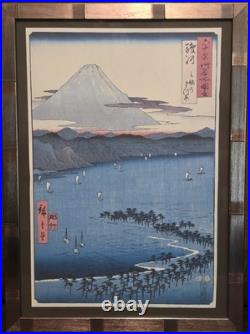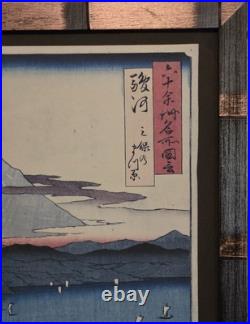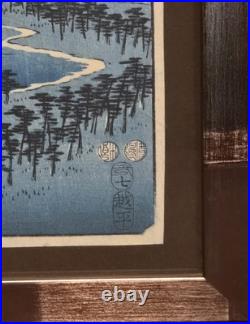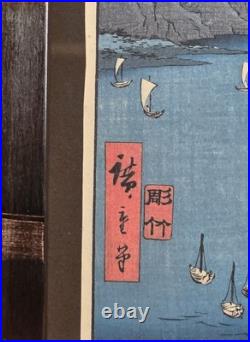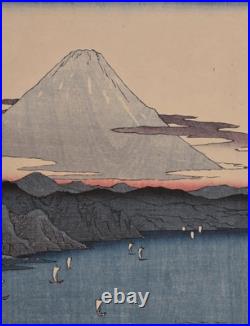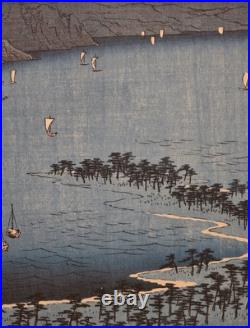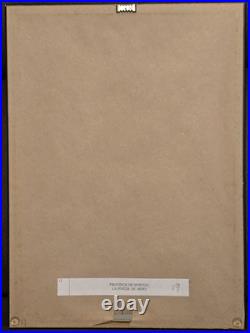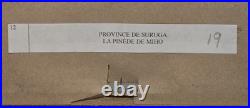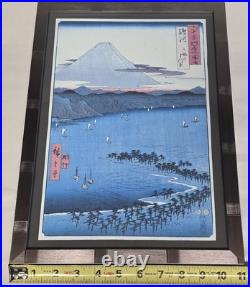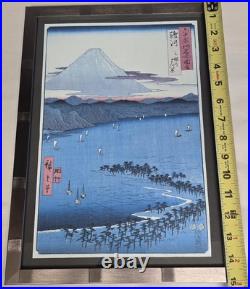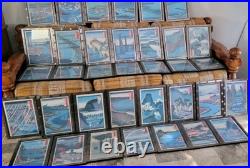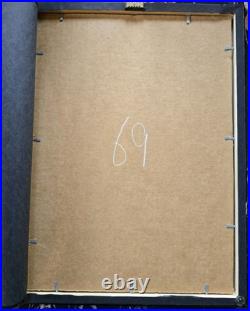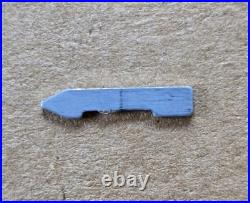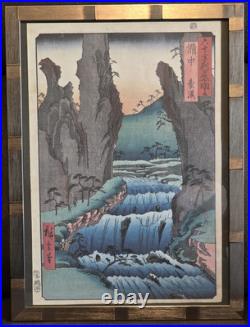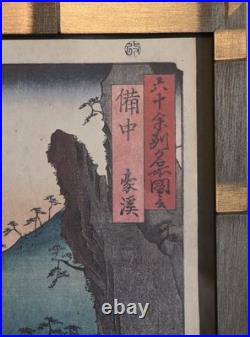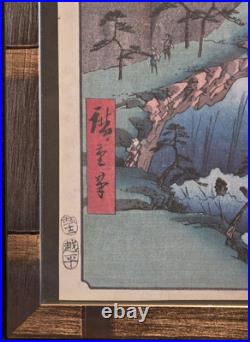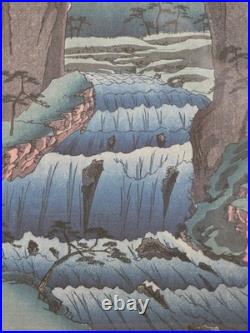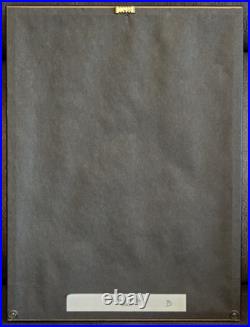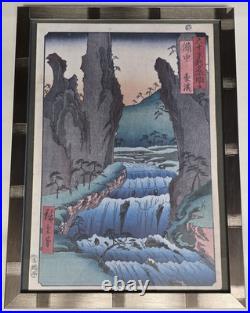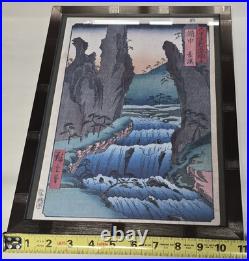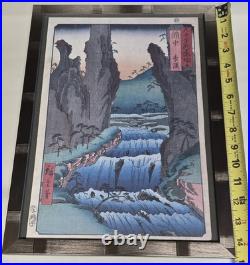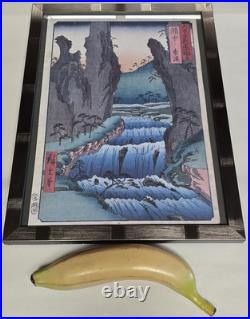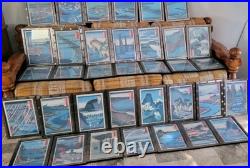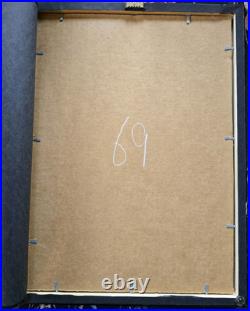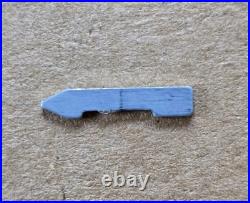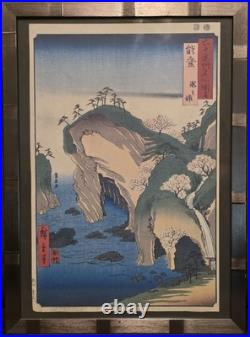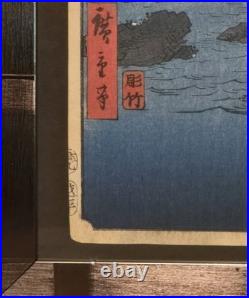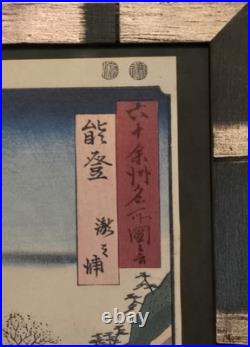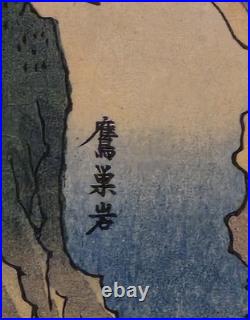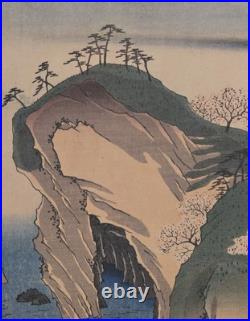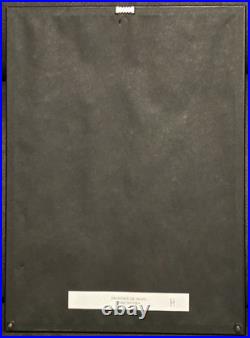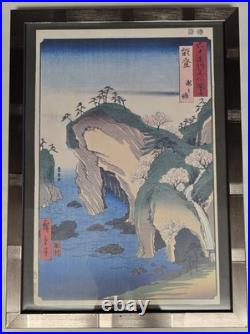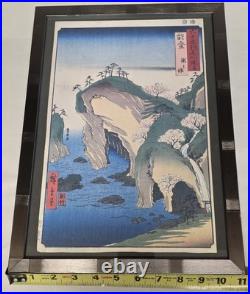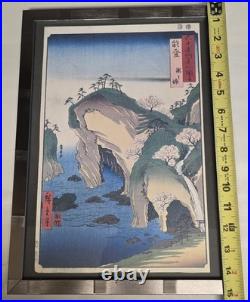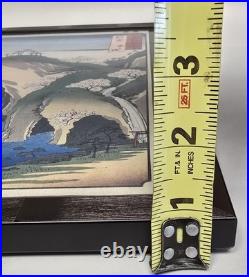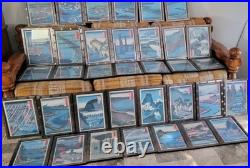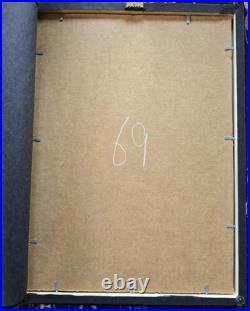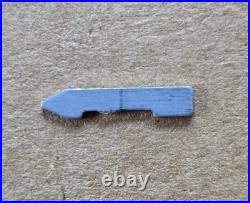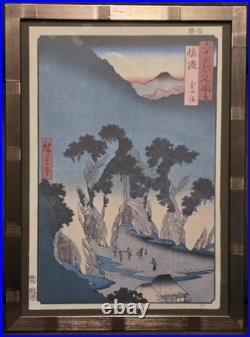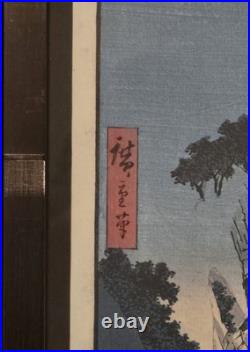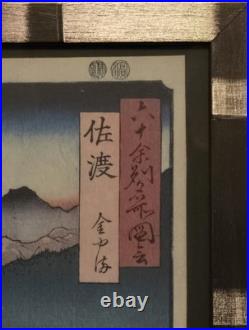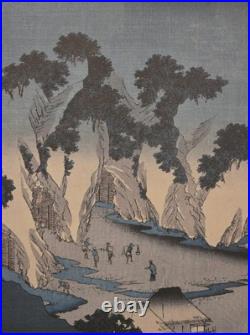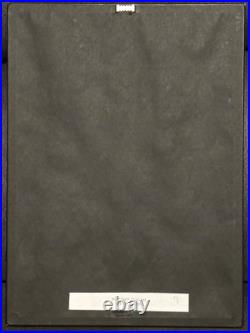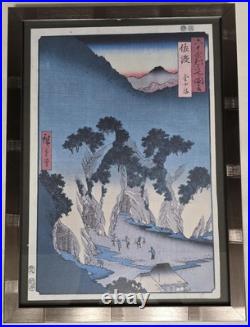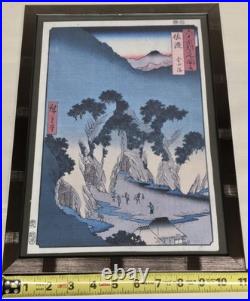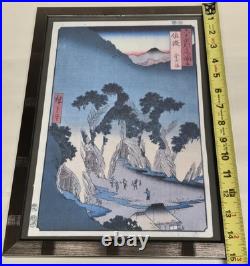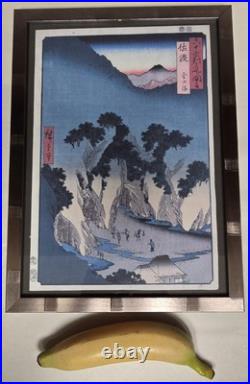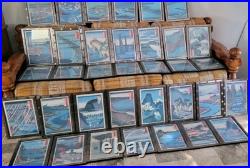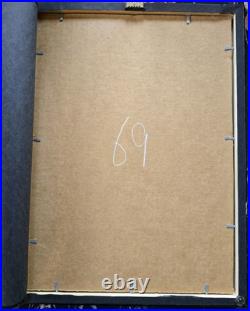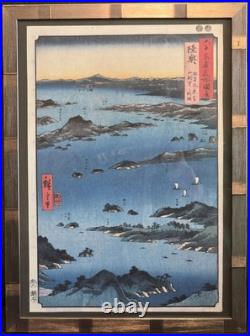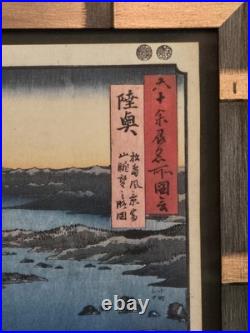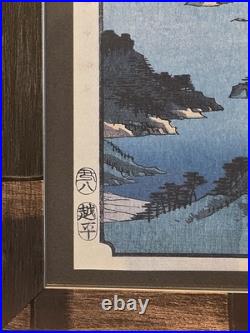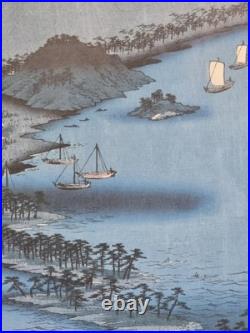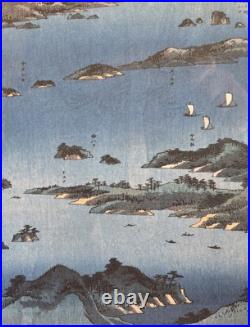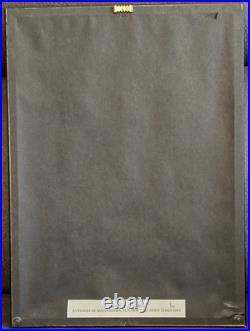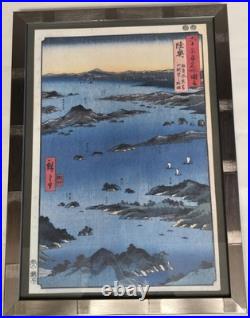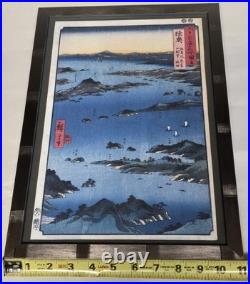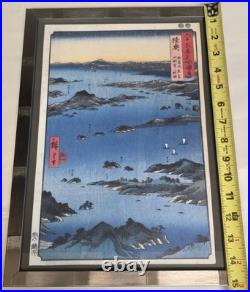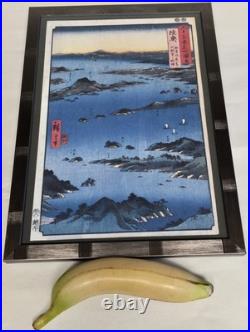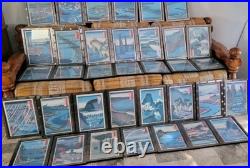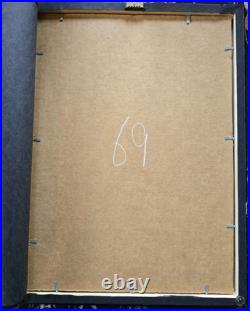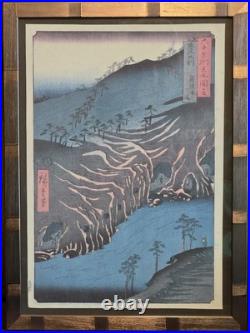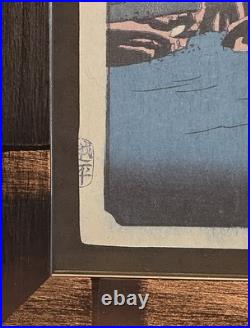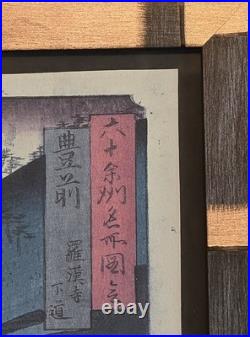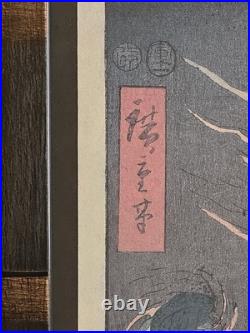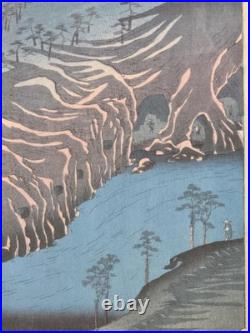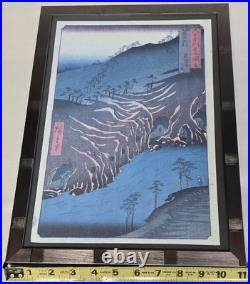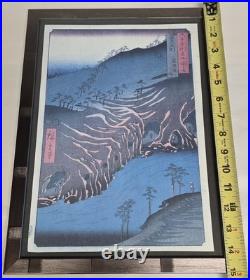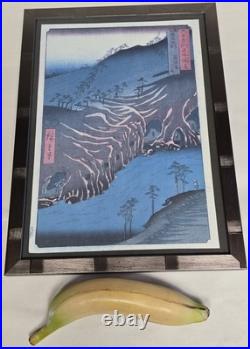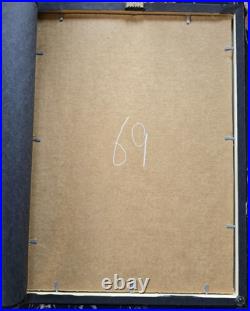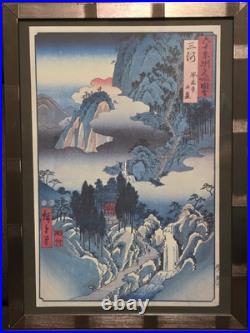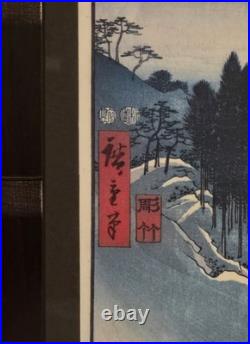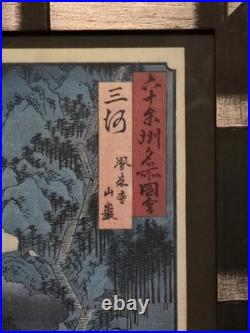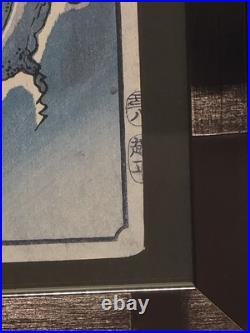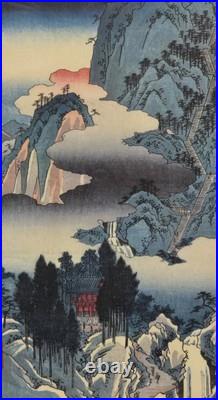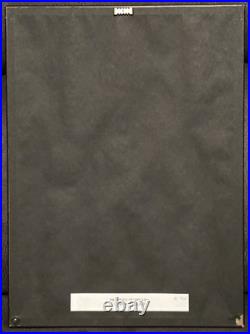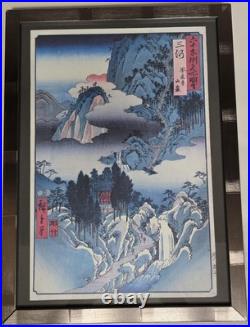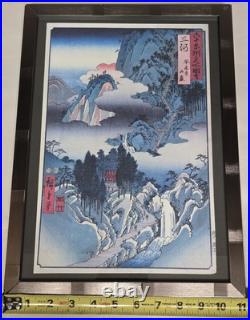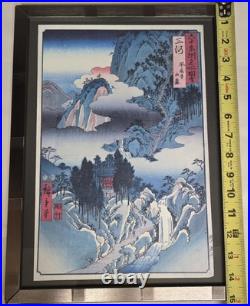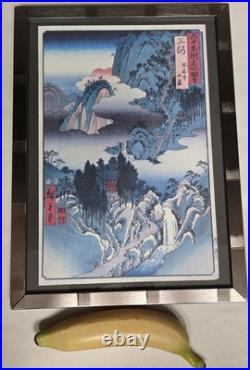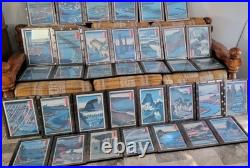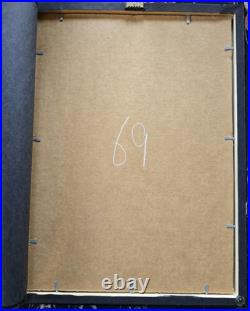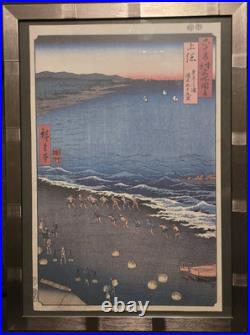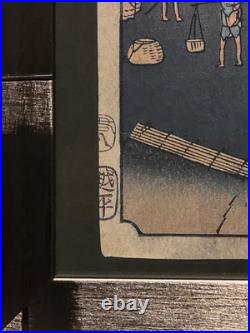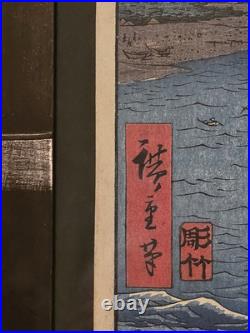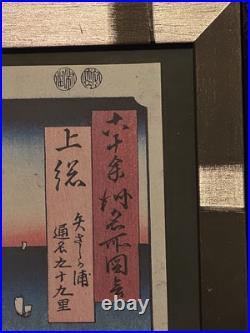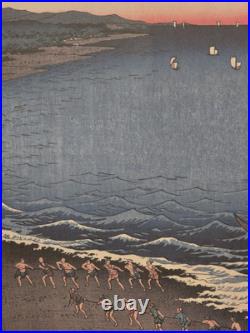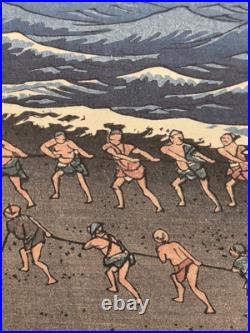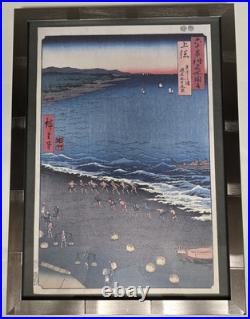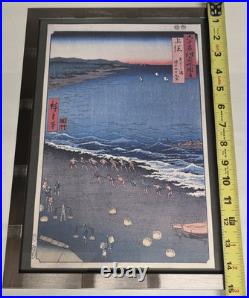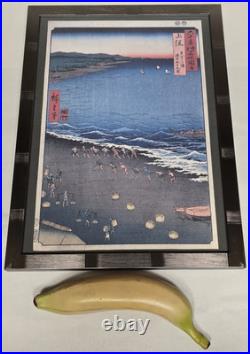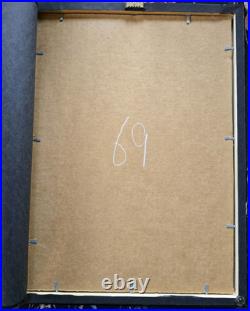SURUGA Province Utagawa Hiroshige Japanese Woodblock Framed Art Print 18×15. PROVINCE DE SURUGA LA PINEDE DE MIHO (Miho Pine Grove, Suruga Province). It is a very beautiful re-print of the original. This is one in a series of 69 prints. As of this listing, I have 35 of them, all professionally framed in a brushed silver toned frame and matted in black They all came from the same Estate in Louisville, KY. All are in excellent condition and any one or all of them would add greatly to your Asian art collection. The last 5 pictures are from one of these that had a damaged back. I deconstructed it so you could see all the layers and materials involved. Terrific, classic Hiroshige depiction of the Miho pine grove and the beautiful view over Suruga Bay. Mount Fuji rises in the distance, wrapped in mist and capped with a light covering of snow. Boats sail along the river towards Shimizu. Lovely Hiroshige landscape view. Born in Edo as Tokutaro Ando, Hiroshige Utagawa grew up in a minor samurai family. His father belonged to the firefighting force assigned to Edo Castle. It is here that Hiroshige was given his first exposure to art: legend has it that a fellow fireman tutored him in the Kano school of painting, though Hiroshige’s first official teacher was Rinsai. Though Hiroshige tried to join Toyokuni Utagawa’s studio, he was turned away. In 1811, young Hiroshige entered an apprenticeship with the celebrated Toyohiro Utagawa. After only a year, he was bestowed with the artist name Hiroshige. He soon gave up his role in the fire department to focus entirely on painting and print design. During this time he studied painting, intrigued by the Shijo school. Hiroshige’s artistic genius went largely unnoticed until 1832. With the Tokugawa Shogunate relaxing centuries of age-old restrictions on travel, urban populations embraced travel art and Hiroshige Utagawa became one of the most prominent and successful ukiyo-e artists. He also produced kacho-e (bird-and-flower pictures) to enormous success. In 1858, at the age of 61, he passed away as a result of the Edo cholera epidemic. Hiroshige Utagawa’s woodblock prints continue to convey the beauty of Japan and provide insight into the everyday life of its citizens during the Edo period. The appeal of his tender, lyrical landscapes was not restricted to the Japanese audience. Hiroshige’s work had a profound influence on the Impressionists and Post-Impressionists of Europe: Toulouse-Lautrec was fascinated with Hiroshige’s daring diagonal compositions and inventive use of perspective, while Van Gogh literally copied two of Hiroshige’s prints from the famous series, 100 Famous Views of Edo in oil paint. Hiroshige (1797 – 1858). Mimasaka Province, Yamabushi Valley. Series: Famous Places in the 60-odd Provinces. Size (H x W): 14.5 x 10.75 (inches). Publisher: Koshimuraya Heisuke (Koshihei). Seals: Date and Aratame. Condition: Very good color and impression, light soiling and wear, embellished with mica.
SURUGA Province Utagawa Hiroshige Japanese Woodblock Framed Art Print 18×15
Author: adminMar 29
BISHU Province Utagawa Hiroshige Japanese Woodblock Framed Art Print 18×15 VTG
Author: adminMar 25
BISHU Province Utagawa Hiroshige Japanese Woodblock Framed Art Print 18×15. PROVINCE DE BISHU GOKEI (GOKEI GORGE). It is a very beautiful re-print of the original. This is one in a series of 69 prints. As of this listing, I have 35 of them, all professionally framed in a brushed silver toned frame and matted in black They all came from the same Estate in Louisville, KY. All are in excellent condition and any one or all of them would add greatly to your Asian art collection. The last 5 pictures are from one of these that had a damaged back. I deconstructed it so you could see all the layers and materials involved. The image is a woodblock print titled “Bitchu Province, Gokei” from the series “Famous Views of the Sixty-odd Provinces” by Utagawa Hiroshige. It was created around 1856. Depicts the Gokei Gorge in Bitchu Province, Japan. Features a vertical composition emphasizing the height and depth of the landscape. Showcases a cascading waterfall between rocky cliffs. Part of a series capturing famous locations throughout Japan. The text on the print reads “Bitchu Gokei” and “Famous Views of the Sixty-odd Provinces”. Born in Edo as Tokutaro Ando, Hiroshige Utagawa grew up in a minor samurai family. His father belonged to the firefighting force assigned to Edo Castle. It is here that Hiroshige was given his first exposure to art: legend has it that a fellow fireman tutored him in the Kano school of painting, though Hiroshige’s first official teacher was Rinsai. Though Hiroshige tried to join Toyokuni Utagawa’s studio, he was turned away. In 1811, young Hiroshige entered an apprenticeship with the celebrated Toyohiro Utagawa. After only a year, he was bestowed with the artist name Hiroshige. He soon gave up his role in the fire department to focus entirely on painting and print design. During this time he studied painting, intrigued by the Shijo school. Hiroshige’s artistic genius went largely unnoticed until 1832. With the Tokugawa Shogunate relaxing centuries of age-old restrictions on travel, urban populations embraced travel art and Hiroshige Utagawa became one of the most prominent and successful ukiyo-e artists. He also produced kacho-e (bird-and-flower pictures) to enormous success. In 1858, at the age of 61, he passed away as a result of the Edo cholera epidemic. Hiroshige Utagawa’s woodblock prints continue to convey the beauty of Japan and provide insight into the everyday life of its citizens during the Edo period. The appeal of his tender, lyrical landscapes was not restricted to the Japanese audience. Hiroshige’s work had a profound influence on the Impressionists and Post-Impressionists of Europe: Toulouse-Lautrec was fascinated with Hiroshige’s daring diagonal compositions and inventive use of perspective, while Van Gogh literally copied two of Hiroshige’s prints from the famous series, 100 Famous Views of Edo in oil paint. Hiroshige (1797 – 1858). Mimasaka Province, Yamabushi Valley. Series: Famous Places in the 60-odd Provinces. Size (H x W): 14.5 x 10.75 (inches). Publisher: Koshimuraya Heisuke (Koshihei). Seals: Date and Aratame. Condition: Very good color and impression, light soiling and wear, embellished with mica.
NOTO Province Utagawa Hiroshige Japanese Woodblock Framed Art Print 18×15 VTG
Author: adminMar 22
NOTO Province Utagawa Hiroshige Japanese Woodblock Framed Art Print 18×15. PROVINCE DE NOTO TAKI NO URA(Noto Province, Waterfall Bay) It is a very beautiful re-print of the original. This is one in a series of 69 prints. As of this listing, I have 35 of them, all professionally framed in a brushed silver toned frame and matted in black They all came from the same Estate in Louisville, KY. All are in excellent condition and any one or all of them would add greatly to your Asian art collection. The last 5 pictures are from one of these that had a damaged back. I deconstructed it so you could see all the layers and materials involved. Part of a series depicting famous views from each of Japan’s provinces. Shows Waterfall Bay in Noto Province with a waterfall, Ganman Cave, and “Falcon Nest Rock”. The vertical format is a distinctive feature of the series. Published between 1853 and 1856. The print captures the beauty of the Japanese landscape during the Edo period. The text on the print includes the series title, province name (Noto), and the carver’s name. Born in Edo as Tokutaro Ando, Hiroshige Utagawa grew up in a minor samurai family. His father belonged to the firefighting force assigned to Edo Castle. It is here that Hiroshige was given his first exposure to art: legend has it that a fellow fireman tutored him in the Kano school of painting, though Hiroshige’s first official teacher was Rinsai. Though Hiroshige tried to join Toyokuni Utagawa’s studio, he was turned away. In 1811, young Hiroshige entered an apprenticeship with the celebrated Toyohiro Utagawa. After only a year, he was bestowed with the artist name Hiroshige. He soon gave up his role in the fire department to focus entirely on painting and print design. During this time he studied painting, intrigued by the Shijo school. Hiroshige’s artistic genius went largely unnoticed until 1832. With the Tokugawa Shogunate relaxing centuries of age-old restrictions on travel, urban populations embraced travel art and Hiroshige Utagawa became one of the most prominent and successful ukiyo-e artists. He also produced kacho-e (bird-and-flower pictures) to enormous success. In 1858, at the age of 61, he passed away as a result of the Edo cholera epidemic. Hiroshige Utagawa’s woodblock prints continue to convey the beauty of Japan and provide insight into the everyday life of its citizens during the Edo period. The appeal of his tender, lyrical landscapes was not restricted to the Japanese audience. Hiroshige’s work had a profound influence on the Impressionists and Post-Impressionists of Europe: Toulouse-Lautrec was fascinated with Hiroshige’s daring diagonal compositions and inventive use of perspective, while Van Gogh literally copied two of Hiroshige’s prints from the famous series, 100 Famous Views of Edo in oil paint. Hiroshige (1797 – 1858). Mimasaka Province, Yamabushi Valley. Series: Famous Places in the 60-odd Provinces. Size (H x W): 14.5 x 10.75 (inches). Publisher: Koshimuraya Heisuke (Koshihei). Seals: Date and Aratame. Condition: Very good color and impression, light soiling and wear, embellished with mica.
SADO Province Utagawa Hiroshige Japanese Woodblock Framed Art Print 18×15 VTG
Author: adminMar 22
SADO Province Utagawa Hiroshige Japanese Woodblock Framed Art Print 18×15. PROVINCE DE SADO ENOSHIMA, LES MINES D’OR (ENTRANCE TO THE CAVE AT ENOSHIMA) It is a very beautiful re-print of the original. This is one in a series of 69 prints. As of this listing, I have 35 of them, all professionally framed in a brushed silver toned frame and matted in black They all came from the same Estate in Louisville, KY. All are in excellent condition and any one or all of them would add greatly to your Asian art collection. The last 5 pictures are from one of these that had a damaged back. I deconstructed it so you could see all the layers and materials involved. The artwork is a woodblock print titled “Sado Province, the Goldmines” by Hiroshige, part of the series “Famous Views of the Sixty-odd Provinces” (Rokujuyoshu Meisho Zue). Created between 1853 and 1856. Depicts the Sado gold mine in Sado Province, Japan. Features a vertical format, unusual for landscapes, allowing for perspective play. Part of a series of 70 prints, showcasing famous views from each of Japan’s provinces. Published by Koshimuraya Heisuke. Known for its use of bokashi (gradation printing). May have been inspired by travel guides or Hokusai’s sketches. Born in Edo as Tokutaro Ando, Hiroshige Utagawa grew up in a minor samurai family. His father belonged to the firefighting force assigned to Edo Castle. It is here that Hiroshige was given his first exposure to art: legend has it that a fellow fireman tutored him in the Kano school of painting, though Hiroshige’s first official teacher was Rinsai. Though Hiroshige tried to join Toyokuni Utagawa’s studio, he was turned away. In 1811, young Hiroshige entered an apprenticeship with the celebrated Toyohiro Utagawa. After only a year, he was bestowed with the artist name Hiroshige. He soon gave up his role in the fire department to focus entirely on painting and print design. During this time he studied painting, intrigued by the Shijo school. Hiroshige’s artistic genius went largely unnoticed until 1832. With the Tokugawa Shogunate relaxing centuries of age-old restrictions on travel, urban populations embraced travel art and Hiroshige Utagawa became one of the most prominent and successful ukiyo-e artists. He also produced kacho-e (bird-and-flower pictures) to enormous success. In 1858, at the age of 61, he passed away as a result of the Edo cholera epidemic. Hiroshige Utagawa’s woodblock prints continue to convey the beauty of Japan and provide insight into the everyday life of its citizens during the Edo period. The appeal of his tender, lyrical landscapes was not restricted to the Japanese audience. Hiroshige’s work had a profound influence on the Impressionists and Post-Impressionists of Europe: Toulouse-Lautrec was fascinated with Hiroshige’s daring diagonal compositions and inventive use of perspective, while Van Gogh literally copied two of Hiroshige’s prints from the famous series, 100 Famous Views of Edo in oil paint. Hiroshige (1797 – 1858). Mimasaka Province, Yamabushi Valley. Series: Famous Places in the 60-odd Provinces. Size (H x W): 14.5 x 10.75 (inches). Publisher: Koshimuraya Heisuke (Koshihei). Seals: Date and Aratame. Condition: Very good color and impression, light soiling and wear, embellished with mica.
MUTSU Province Utagawa Hiroshige Japanese Woodblock Framed Art Print 18×15 VTG
Author: adminMar 21
MUTSU Province Utagawa Hiroshige Japanese Woodblock Framed Art Print 18×15. PAYSAGES DE MATSUSHIMA, VUE DE PUIS LE MONT TOMIYAMA (Sight Map from Mount Tomi) It is a very beautiful re-print of the original. This is one in a series of 69 prints. As of this listing, I have 35 of them, all professionally framed in a brushed silver toned frame and matted in black They all came from the same Estate in Louisville, KY. All are in excellent condition and any one or all of them would add greatly to your Asian art collection. The last 5 pictures are from one of these that had a damaged back. I deconstructed it so you could see all the layers and materials involved. The image is a woodblock print titled “Goshiki Beach, Awaji Province” from the series Famous Views of the Sixty-odd Provinces by Utagawa Hiroshige, dating back to 1855. Depicts fishermen hauling nets at Goshiki Beach in Awaji Province, known for its abundant fish. Part of a collection of 70 prints showcasing famous locations across Japan’s provinces. Features a vertical format, emphasizing depth and perspective, characteristic of Hiroshige’s later works. Utilizes bokashi (color gradation) to create depth and atmosphere, enhancing the visual impact. Reflects the growing interest in travel and pilgrimage during the Edo period. Born in Edo as Tokutaro Ando, Hiroshige Utagawa grew up in a minor samurai family. His father belonged to the firefighting force assigned to Edo Castle. It is here that Hiroshige was given his first exposure to art: legend has it that a fellow fireman tutored him in the Kano school of painting, though Hiroshige’s first official teacher was Rinsai. Though Hiroshige tried to join Toyokuni Utagawa’s studio, he was turned away. In 1811, young Hiroshige entered an apprenticeship with the celebrated Toyohiro Utagawa. After only a year, he was bestowed with the artist name Hiroshige. He soon gave up his role in the fire department to focus entirely on painting and print design. During this time he studied painting, intrigued by the Shijo school. Hiroshige’s artistic genius went largely unnoticed until 1832. With the Tokugawa Shogunate relaxing centuries of age-old restrictions on travel, urban populations embraced travel art and Hiroshige Utagawa became one of the most prominent and successful ukiyo-e artists. He also produced kacho-e (bird-and-flower pictures) to enormous success. In 1858, at the age of 61, he passed away as a result of the Edo cholera epidemic. Hiroshige Utagawa’s woodblock prints continue to convey the beauty of Japan and provide insight into the everyday life of its citizens during the Edo period. The appeal of his tender, lyrical landscapes was not restricted to the Japanese audience. Hiroshige’s work had a profound influence on the Impressionists and Post-Impressionists of Europe: Toulouse-Lautrec was fascinated with Hiroshige’s daring diagonal compositions and inventive use of perspective, while Van Gogh literally copied two of Hiroshige’s prints from the famous series, 100 Famous Views of Edo in oil paint. Hiroshige (1797 – 1858). Mimasaka Province, Yamabushi Valley. Series: Famous Places in the 60-odd Provinces. Size (H x W): 14.5 x 10.75 (inches). Publisher: Koshimuraya Heisuke (Koshihei). Seals: Date and Aratame. Condition: Very good color and impression, light soiling and wear, embellished with mica.
BUZEN Province Utagawa Hiroshige Japanese Woodblock Framed Art Print 18×15 VTG
Author: adminMar 17
BUZEN Province Utagawa Hiroshige Japanese Woodblock Framed Art Print 18×15. PROVINCE DE BUZEN, LES SOUTERRAINS DU RAKAN-JI (The Passage Under the Rakan Monastery, Buzen Province) It is a very beautiful re-print of the original. This is one in a series of 69 prints. As of this listing, I have 35 of them, all professionally framed in a brushed silver toned frame and matted in black They all came from the same Estate in Louisville, KY. All are in excellent condition and any one or all of them would add greatly to your Asian art collection. The last 5 pictures are from one of these that had a damaged back. I deconstructed it so you could see all the layers and materials involved. Monastery, Buzen Province” by Utagawa Hiroshige, part of the series “Famous Views of the Sixty-odd Provinces. Key information about the print. Series: “Famous Views of the Sixty-odd Provinces” (Rokujuyoshu Meisho Zue). Date: Published between 1853 and 1856. This specific print is from 1854. Subject: Depicts the Rakan Monastery in Buzen Province (present-day Fukuoka and Oita Prefectures). It focuses on the caves at the cliff base, with pilgrims visible in the openings. Style: Vertical format, characteristic of the series, allowing for foreground and background contrasts. Technique: Woodblock print (ukiyo-e) with bokashi shading to add depth. Location: Rakan Temple is a Zen Buddhist site dating back to the 13th century. Inspiration: Hiroshige likely drew inspiration from travel guides and possibly Hokusai’s sketches, rather than visiting every location himself. Born in Edo as Tokutaro Ando, Hiroshige Utagawa grew up in a minor samurai family. His father belonged to the firefighting force assigned to Edo Castle. It is here that Hiroshige was given his first exposure to art: legend has it that a fellow fireman tutored him in the Kano school of painting, though Hiroshige’s first official teacher was Rinsai. Though Hiroshige tried to join Toyokuni Utagawa’s studio, he was turned away. In 1811, young Hiroshige entered an apprenticeship with the celebrated Toyohiro Utagawa. After only a year, he was bestowed with the artist name Hiroshige. He soon gave up his role in the fire department to focus entirely on painting and print design. During this time he studied painting, intrigued by the Shijo school. Hiroshige’s artistic genius went largely unnoticed until 1832. With the Tokugawa Shogunate relaxing centuries of age-old restrictions on travel, urban populations embraced travel art and Hiroshige Utagawa became one of the most prominent and successful ukiyo-e artists. He also produced kacho-e (bird-and-flower pictures) to enormous success. In 1858, at the age of 61, he passed away as a result of the Edo cholera epidemic. Hiroshige Utagawa’s woodblock prints continue to convey the beauty of Japan and provide insight into the everyday life of its citizens during the Edo period. The appeal of his tender, lyrical landscapes was not restricted to the Japanese audience. Hiroshige’s work had a profound influence on the Impressionists and Post-Impressionists of Europe: Toulouse-Lautrec was fascinated with Hiroshige’s daring diagonal compositions and inventive use of perspective, while Van Gogh literally copied two of Hiroshige’s prints from the famous series, 100 Famous Views of Edo in oil paint. Hiroshige (1797 – 1858). Mimasaka Province, Yamabushi Valley. Series: Famous Places in the 60-odd Provinces. Size (H x W): 14.5 x 10.75 (inches). Publisher: Koshimuraya Heisuke (Koshihei). Seals: Date and Aratame. Condition: Very good color and impression, light soiling and wear, embellished with mica.
MIKAWA Province Utagawa Hiroshige Japanese Woodblock Framed Art Print 18×15 VTG
Author: adminMar 17
MIKAWA Province Utagawa Hiroshige Japanese Woodblock Framed Art Print 18×15. PROVINCE DE MIKAWA LE MONT HORAI-JI (Horai Temple, Mikawa Province) It is a very beautiful re-print of the original. This is one in a series of 69 prints. As of this listing, I have 35 of them, all professionally framed in a brushed silver toned frame and matted in black They all came from the same Estate in Louisville, KY. All are in excellent condition and any one or all of them would add greatly to your Asian art collection. The last 5 pictures are from one of these that had a damaged back. I deconstructed it so you could see all the layers and materials involved. The image is a woodblock print titled “Horai Temple, Mikawa Province” by Utagawa Hiroshige, part of the series “Famous Views of the Sixty-odd Provinces”. It was published around 1853. Key information about the print. Series: “Famous Views of the Sixty-odd Provinces, ” featuring scenes from each of Japan’s provinces. Subject: Depicts Horai Temple nestled in the steep mountains of Mikawa Province (present-day Aichi Prefecture). Style: Ukiyo-e, characterized by its depiction of everyday life and landscapes. Technique: Woodblock print (nishiki-e), using ink and colors on paper. Hiroshige was known for his perspective and color gradation (bokashi). Temple: Horai Temple was a Shingon Buddhist temple and a popular pilgrimage site during the Edo period. Location: The former Mikawa Province is now the eastern half of Aichi Prefecture. Born in Edo as Tokutaro Ando, Hiroshige Utagawa grew up in a minor samurai family. His father belonged to the firefighting force assigned to Edo Castle. It is here that Hiroshige was given his first exposure to art: legend has it that a fellow fireman tutored him in the Kano school of painting, though Hiroshige’s first official teacher was Rinsai. Though Hiroshige tried to join Toyokuni Utagawa’s studio, he was turned away. In 1811, young Hiroshige entered an apprenticeship with the celebrated Toyohiro Utagawa. After only a year, he was bestowed with the artist name Hiroshige. He soon gave up his role in the fire department to focus entirely on painting and print design. During this time he studied painting, intrigued by the Shijo school. Hiroshige’s artistic genius went largely unnoticed until 1832. With the Tokugawa Shogunate relaxing centuries of age-old restrictions on travel, urban populations embraced travel art and Hiroshige Utagawa became one of the most prominent and successful ukiyo-e artists. He also produced kacho-e (bird-and-flower pictures) to enormous success. In 1858, at the age of 61, he passed away as a result of the Edo cholera epidemic. Hiroshige Utagawa’s woodblock prints continue to convey the beauty of Japan and provide insight into the everyday life of its citizens during the Edo period. The appeal of his tender, lyrical landscapes was not restricted to the Japanese audience. Hiroshige’s work had a profound influence on the Impressionists and Post-Impressionists of Europe: Toulouse-Lautrec was fascinated with Hiroshige’s daring diagonal compositions and inventive use of perspective, while Van Gogh literally copied two of Hiroshige’s prints from the famous series, 100 Famous Views of Edo in oil paint. Hiroshige (1797 – 1858). Mimasaka Province, Yamabushi Valley. Series: Famous Places in the 60-odd Provinces. Size (H x W): 14.5 x 10.75 (inches). Publisher: Koshimuraya Heisuke (Koshihei). Seals: Date and Aratame. Condition: Very good color and impression, light soiling and wear, embellished with mica.
KAZUSA Province Utagawa Hiroshige Japanese Woodblock Framed Art Print 18×15
Author: adminMar 16
KAZUSA Province Utagawa Hiroshige Japanese Woodblock Framed Art Print 18×15. PROVINCE DE KAZUSA, NOM USUEL ; KUJUKURI (YASASHI BAY) It is a very beautiful re-print of the original. This is one in a series of 69 prints. As of this listing, I have 35 of them, all professionally framed in a brushed silver toned frame and matted in black They all came from the same Estate in Louisville, KY. All are in excellent condition and any one or all of them would add greatly to your Asian art collection. The last 5 pictures are from one of these that had a damaged back. I deconstructed it so you could see all the layers and materials involved. It depicts a scene of fishermen hauling nets at Yasashi Bay in Kazusa Province, also known as Kujukuri Beach. The print is part of a series of 70 landscape prints showcasing famous locations in Japan’s provinces. It uses a vertical format, which was novel for landscape prints at the time. The series was inspired by travel guides and Hokusai’s sketches. The print utilizes bokashi (gradation printing). It shows the collaborative effort of fishermen pulling in large fishing nets, likely for sardines, a common catch in the area. Lanterns mark the shoreline and boats dot the sea, adding depth and perspective. The series gained popularity and went through multiple editions. Born in Edo as Tokutaro Ando, Hiroshige Utagawa grew up in a minor samurai family. His father belonged to the firefighting force assigned to Edo Castle. It is here that Hiroshige was given his first exposure to art: legend has it that a fellow fireman tutored him in the Kano school of painting, though Hiroshige’s first official teacher was Rinsai. Though Hiroshige tried to join Toyokuni Utagawa’s studio, he was turned away. In 1811, young Hiroshige entered an apprenticeship with the celebrated Toyohiro Utagawa. After only a year, he was bestowed with the artist name Hiroshige. He soon gave up his role in the fire department to focus entirely on painting and print design. During this time he studied painting, intrigued by the Shijo school. Hiroshige’s artistic genius went largely unnoticed until 1832. With the Tokugawa Shogunate relaxing centuries of age-old restrictions on travel, urban populations embraced travel art and Hiroshige Utagawa became one of the most prominent and successful ukiyo-e artists. He also produced kacho-e (bird-and-flower pictures) to enormous success. In 1858, at the age of 61, he passed away as a result of the Edo cholera epidemic. Hiroshige Utagawa’s woodblock prints continue to convey the beauty of Japan and provide insight into the everyday life of its citizens during the Edo period. The appeal of his tender, lyrical landscapes was not restricted to the Japanese audience. Hiroshige’s work had a profound influence on the Impressionists and Post-Impressionists of Europe: Toulouse-Lautrec was fascinated with Hiroshige’s daring diagonal compositions and inventive use of perspective, while Van Gogh literally copied two of Hiroshige’s prints from the famous series, 100 Famous Views of Edo in oil paint. Hiroshige (1797 – 1858). Mimasaka Province, Yamabushi Valley. Series: Famous Places in the 60-odd Provinces. Size (H x W): 14.5 x 10.75 (inches). Publisher: Koshimuraya Heisuke (Koshihei). Seals: Date and Aratame. Condition: Very good color and impression, light soiling and wear, embellished with mica.
YAMASHIRO Province Utagawa Hiroshige Japanese Woodblock Framed Art Print 18×15
Author: adminMar 15
YAMASHIRO Province Utagawa Hiroshige Japanese Woodblock Framed Art Print 18×15. PROVINCE DE YAMASHIRO, ARISHIYAMA, LE PONT DE TOGETSU (THE MOON CROSSING BRIDGE AT ARISHIYAMO) It is a very beautiful re-print of the original. This is one in a series of 69 prints. As of this listing, I have 35 of them, all professionally framed in a brushed silver toned frame and matted in black They all came from the same Estate in Louisville, KY. All are in excellent condition and any one or all of them would add greatly to your Asian art collection. The last 5 pictures are from one of these that had a damaged back. I deconstructed it so you could see all the layers and materials involved. It depicts the Togetsukyo Bridge in Arashiyama, Kyoto, a well-known scenic spot. The bridge, meaning “moon crossing bridge, ” got its name from Emperor Kameyama, who thought the moon looked like it was crossing the bridge during a boat party. The print showcases the bridge with cherry trees in bloom, a popular seasonal attraction. While the bridge appears wooden, its structure is reinforced concrete, with only the parapets made of cypress wood. The artwork is a vertical oban print, a format that allowed Hiroshige to experiment with perspective and create a sense of depth. The print is a later variant, recognizable by the darker sky and different coloring of the clouds and cartouche compared to earlier versions. The bridge has a long history, with the first version built in 836, though the current structure dates to 1934. Born in Edo as Tokutaro Ando, Hiroshige Utagawa grew up in a minor samurai family. His father belonged to the firefighting force assigned to Edo Castle. It is here that Hiroshige was given his first exposure to art: legend has it that a fellow fireman tutored him in the Kano school of painting, though Hiroshige’s first official teacher was Rinsai. Though Hiroshige tried to join Toyokuni Utagawa’s studio, he was turned away. In 1811, young Hiroshige entered an apprenticeship with the celebrated Toyohiro Utagawa. After only a year, he was bestowed with the artist name Hiroshige. He soon gave up his role in the fire department to focus entirely on painting and print design. During this time he studied painting, intrigued by the Shijo school. Hiroshige’s artistic genius went largely unnoticed until 1832. With the Tokugawa Shogunate relaxing centuries of age-old restrictions on travel, urban populations embraced travel art and Hiroshige Utagawa became one of the most prominent and successful ukiyo-e artists. He also produced kacho-e (bird-and-flower pictures) to enormous success. In 1858, at the age of 61, he passed away as a result of the Edo cholera epidemic. Hiroshige Utagawa’s woodblock prints continue to convey the beauty of Japan and provide insight into the everyday life of its citizens during the Edo period. The appeal of his tender, lyrical landscapes was not restricted to the Japanese audience. Hiroshige’s work had a profound influence on the Impressionists and Post-Impressionists of Europe: Toulouse-Lautrec was fascinated with Hiroshige’s daring diagonal compositions and inventive use of perspective, while Van Gogh literally copied two of Hiroshige’s prints from the famous series, 100 Famous Views of Edo in oil paint. Hiroshige (1797 – 1858). Mimasaka Province, Yamabushi Valley. Series: Famous Places in the 60-odd Provinces. Size (H x W): 14.5 x 10.75 (inches). Publisher: Koshimuraya Heisuke (Koshihei). Seals: Date and Aratame. Condition: Very good color and impression, light soiling and wear, embellished with mica.
Vintage Hiroshige Woodblock #28 Nagakubo, The 69 Stations of Kisokaido Road
Author: adminMar 14
28, Nagakubo, from the series The Sixty-nine Stations of the Kisokaidô Road (Kisokaidô rokujûkyû tsugi no uchi). Mat board is 14.5″ x 19.5″ woodblock is 10 x 15. See photos for condition and best description.
